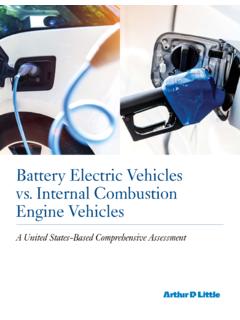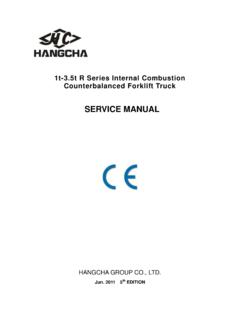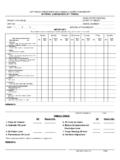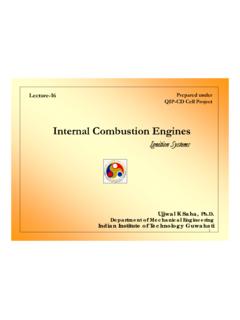Transcription of Age range 10+ - Trends UK
1 HAYNES ASSEMBLY MANUALHAYNES ASSEMBLY MANUALAge range 10+HM04R Haynes Build Your OwnInternal combustion EngineHM04R Haynes Build Your Own internal combustion Engine Kit Haynes Publishing 2015 All rights reserved. No part of this publication may be reproduced, stored in a retrieval system or transmitted, in any form or by any means, electronic, mechanical, photocopying, recording or otherwise, without prior permission in writing from the published in 2007 Published by Haynes PublishingPrinted in ChinaPlease retain the information in this manual for future YOUR OWNINTERNALCOMBUSTIONENGINEC ontentsWhat s this kit all about? .. 2 Before assembling your engine .. 3 Parts list .. 4 Assembling your engine .. 10 How a petrol engine works .. 31 Keeping a car and its engine healthy .. 37 Reducing pollution and saving on fuel bills.
2 37 Basic engine terms .. 38 Adults! Please ensure all instructions in this manual are read, followed, and retained for future under adult ! For children over 10 years of age ! Parts cut off from frames may contain sharp ! Keep fingers well away from moving you follow the instructions carefully, and take your time putting the model together, your engine should work correctly. You ll have earned your Haynes Engineer Certificate, which you can download and print your certificate S THIS KIT ALL ABOUT?BEFORE ASSEMBLING YOUR ENGINE231 First, identify the various parts. Learn their names by looking at the illustrations in this Only remove the parts from the plastic frames as you need them. You ll find illustrations helpful whenever you need to identify a Carefully remove any burrs using a modelling knife or a small file.
3 If you leave the burrs in place, they might stop the engine from working Use the screwdriver included with the kit to fit and tighten the screws that hold the model together. Take care not to over-tighten the Look at the illustrations and think carefully about how each part fits before fitting it permanently take care not to fit a part upside-down or The bearings in your engine should be lightly oiled, just as they would be in a full-size engine. Use a very light coating of vegetable oil, which you should be able to find in your kitchen. Don t use car engine oil!The engine you re about to start building is a greatly simplified version of a real car engine. The model is designed to be fun to put together, and to make it easier for you to understand how a full-size four-stroke car engine works.
4 To keep things simple, the following components which are fitted to a full-size engine don t appear on the model: oil filter, cooling system, air filter, connecting rod bearings, piston rings, oil pump, alternator and starter (a drive module, powered by a small electric motor, is fitted in place of the starter motor.) Also, the following components are included on the model, but don t function as they would on a full-size engine: water pump, throttle body, dipstick (without oil), flywheel and listDetach hereBuild Your Own internal Engine combustion Engine Kit 673436 Assembling Your EngineFitting the sump panAssembling the pistons and connecting rodsASSEMBLING YOUR ENGINE10116 Place the sump pan (part 6) over the studs on the bottom of the lower crankshaft (part 7), and secure with four screws. Note that it will only fit in one Turn the assembly over, and fit to the base.
5 Secure with four screws. 1 Push a gudgeon pin (part 1) through the small end of a connecting rod (part 2).2 Push two halves of a piston (part 3) on to the gudgeon pin, then press together firmly. Ensure the piston rotates Repeat steps 1 and 2 for the other three piston/rod assemblies. 4 The four connecting rods attach to the crankshaft (part 4) at the points indicated. Place the connecting rod over the crankshaft, then fit a bearing cap (part 5) and secure with two screws. Repeat for the other 3 piston/connecting rod Check the completed assembly by turning the crankshaft. The piston/connecting rod assemblies should rotate : use a sharp knife to trim any excess from the components after they have been removed from their carrier the piston/connecting rod assemblies on the crankshaftAssembling Your EngineBuild Your Own internal combustion Engine Kit Fitting the piston/crankshaft assembly to the cylinder blockFitting the springs to thevalve stemsFitting the valves to thelower cylinder headFitting the cylinder block assembly to the lower crankcase12 Remove the eight valve stems (part 12) from their carrier frames, and slide a spring over each Fit the two clear plastic cylinder head plates (parts 6a and 6b) to the lower cylinder head (part 11).
6 Each plate has four round studs which face downwards, into the lower cylinder head. The narrower plate (6a) fits on the side with the smaller holes in the lower cylinder head, the wider plate (6b) on the side with the larger holes. The plates must be pushed down firmly so they clip into The studs in the narrower plate carry the exhaust valves. Pick up the lower cylinder head, then slide a valve stem into one of the holes. Gently push the valve stem, compressing the spring until the end of the stem sticks out the bottom of the head. Carefully push the exhaust valve (part 13) on to the stem. Note that the end of the valve stem has a step push the valve until it touches the edge of the step. Do not force the valve - if necessary, trim any excess plastic from the stem.
7 Repeat for the other three exhaust The studs in the wider plate carry the inlet valves (part 14). Fit these as described above for the exhaust Check that the valves operate correctly- each should move up and down smoothly without Turn the cylinder block the right way up, so the crankshaft is underneath. Hold the ends of the assembly, so the crankshaft stays in position. Fit this assembly to the lower crankcase, making sure that the longer end of the crankshaft is positioned above the end of the crankcase with two studs (as shown). Secure the cylinder block to the crankcase using six Gently turn the crankshaft by hand, making sure that it turns freely, and the pistons move smoothly in their Rest the cylinder block (part 9) upside Hold the piston/crankshaft assembly with the longer end of the crankshaft positioned at the end of the block with the single stud, as shown.
8 The four pistons should slide easily into the cylinders. If not, you may need to scrape away any excess plastic from the inside edge of the cylinders. Lower the crankshaft until it rests on the bearing Your EngineBuild Your Own internal combustion Engine Kit 1415 Fitting the rocker arms to the rocker shaftFitting the rocker arm assembly to the upper cylinder headFitting the cylinder head gasket to the cylinder blockFitting the lower cylinder head to the cylinder block17 Remove the eight rocker arms (part 24) from the carrier frame. Slide the rocker arms on to the metal rocker shaft (3mm diameter/156mm long). The arms must be fitted as shown in the diagram. Note that each successive rocker arm is fitted the opposite way round to the previous arm. Also carefully note the position of the rocker arms in relation to the upper cylinder head - use the studs on either end of the head as a point of Place the cylinder head gasket (part 10) over the cylinder block, using the holes in the gasket to ensure correct Fit the lower cylinder head to the cylinder block.
9 Make sure the end of the cylinder head with the round stud is fitted at the end of the block with the five studs sticking Secure the cylinder head to the block using six Lower the rocker arm assembly on to the upper cylinder head (part 23). Use your fingers to separate the rocker arms into pairs on the shaft, so they fit into the four rectangular holes in the head. The longer arms of the rockers must be positioned over the valve Fit the bearing caps (part 25) as shown using ten screws. Do not overtighten, and check that all rocker arms move Your EngineBuild Your Own internal combustion Engine Kit 1617 Assembling the camshaftFitting the camshaft to the lower cylinder headFitting the upper cylinder head to the lower cylinder headFitting the rocker coverFitting the crankshaftsprocket23 Remove the eight cams (labelled A to H) from the plastic carrier frame.
10 Slide the cams onto the camshaft (3mm diameter/206 mm long), in the following order-A,B,C,D,E,F,G and H. Each cam will only fit in one position. There is a flat surface on the inside of each (refer to the enlarged portion of the diagram), which matches the flat surface on the camshaft. Please also note the rib on one end of each cam. The cams must be fitted so the ribbed portions all face one way (towards the left in the diagram).26 Fit the upper cylinder head assembly (from step 19) to the engine. The end with the two wider spaced studs should be positioned over the end of the cylinder block with three studs sticking out. Check that all of the rocker arms are positioned over the top of the valve stems. Push down on each rocker arm to make sure that they move their corresponding valve.






